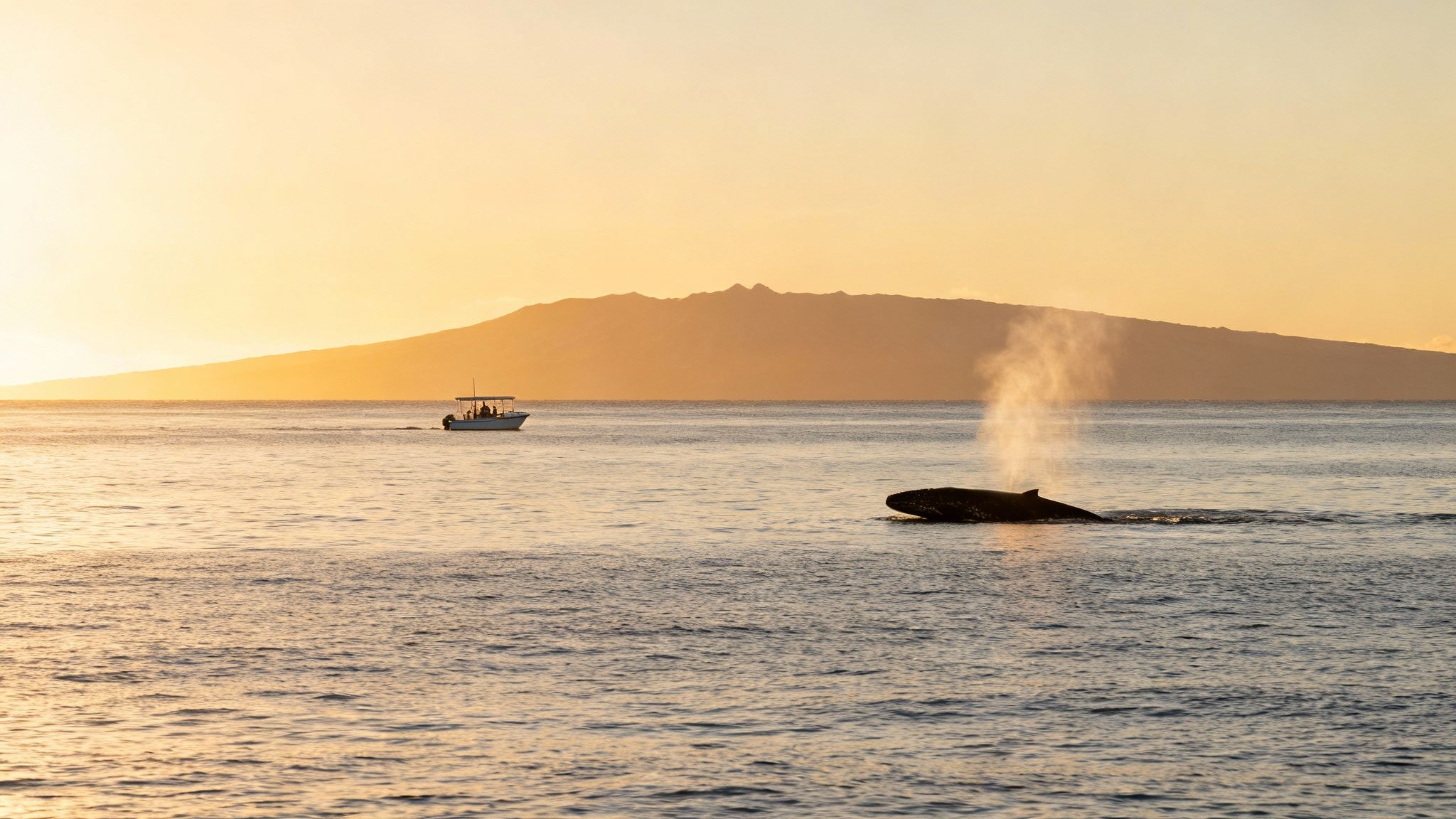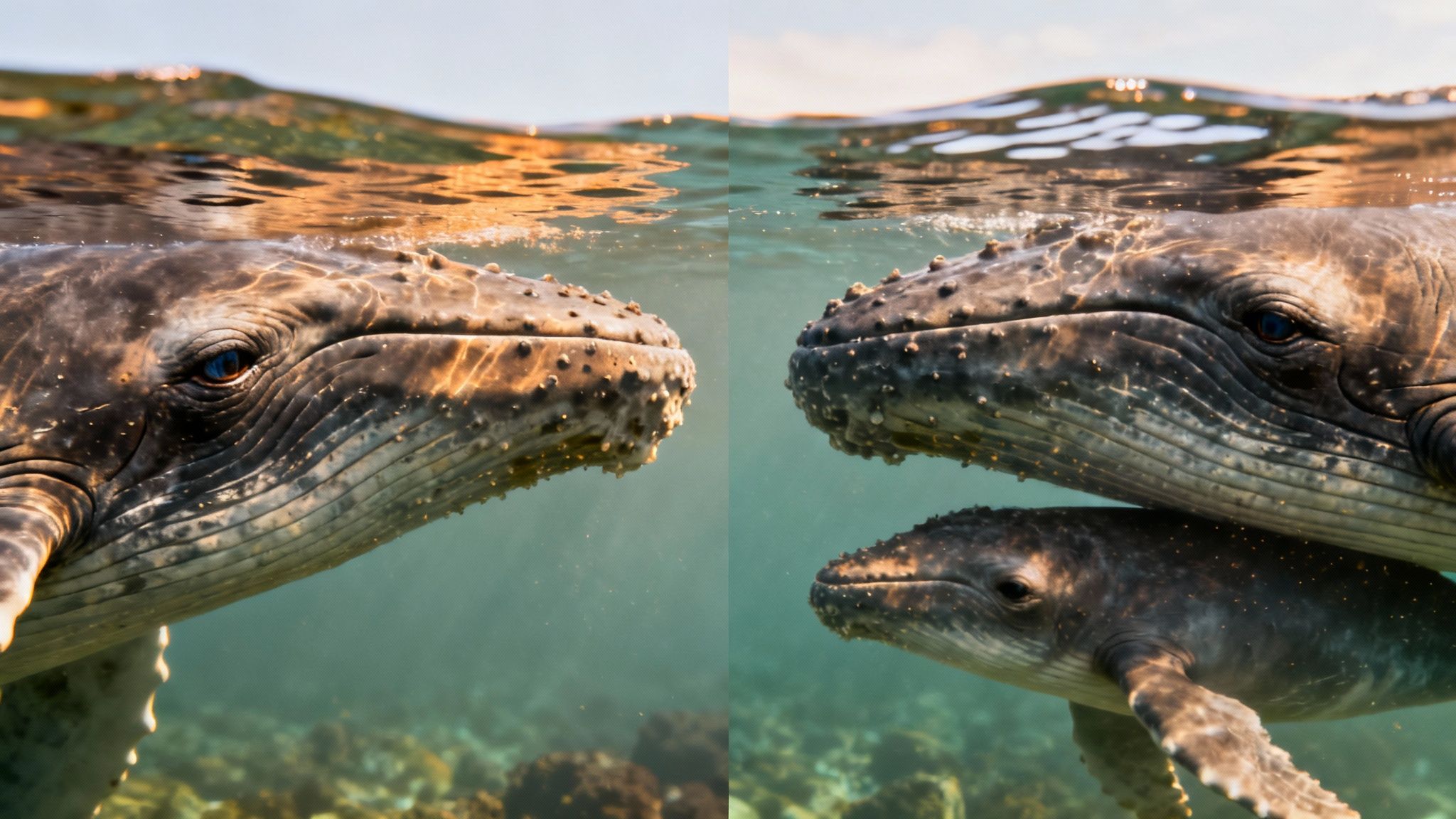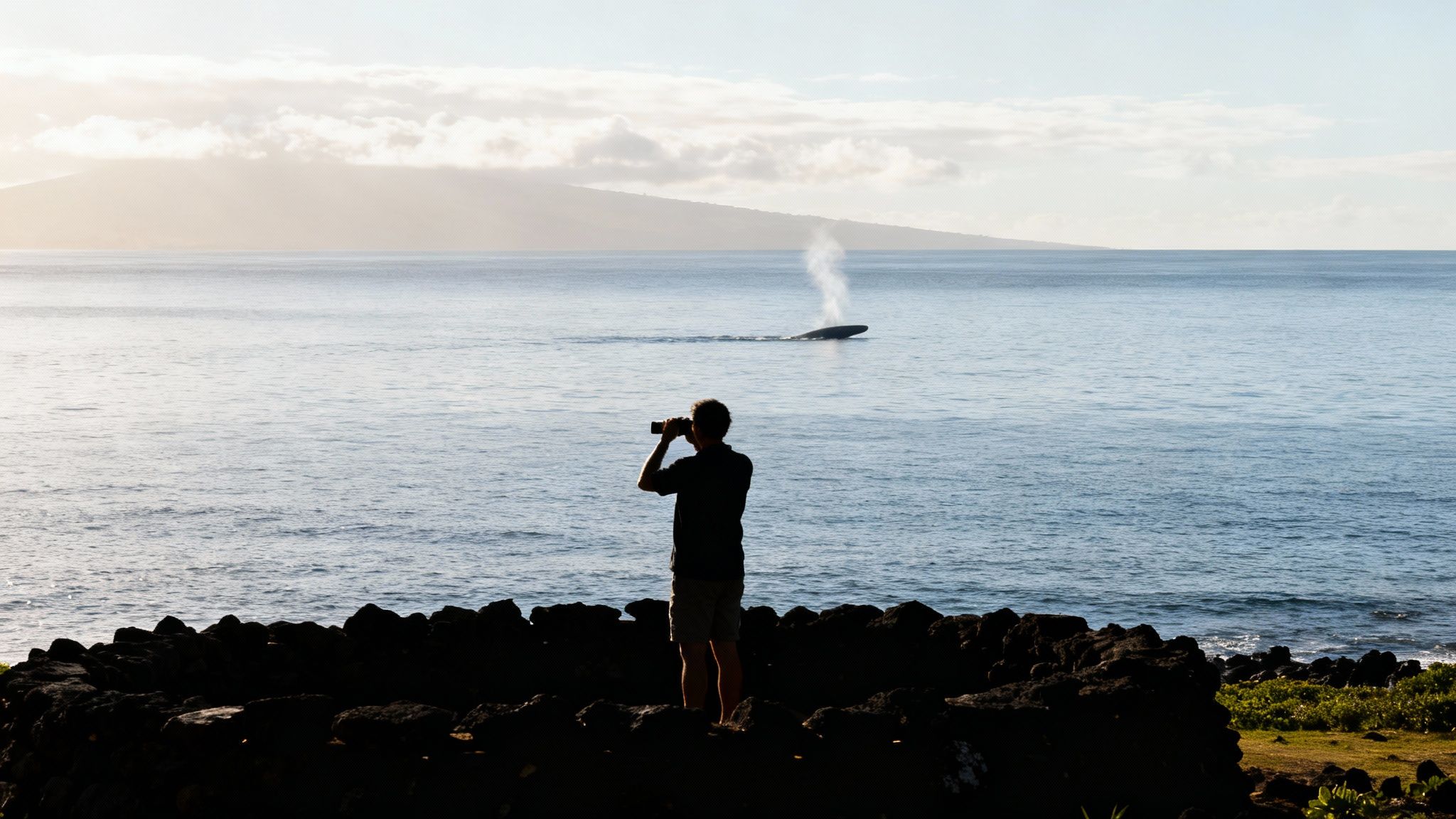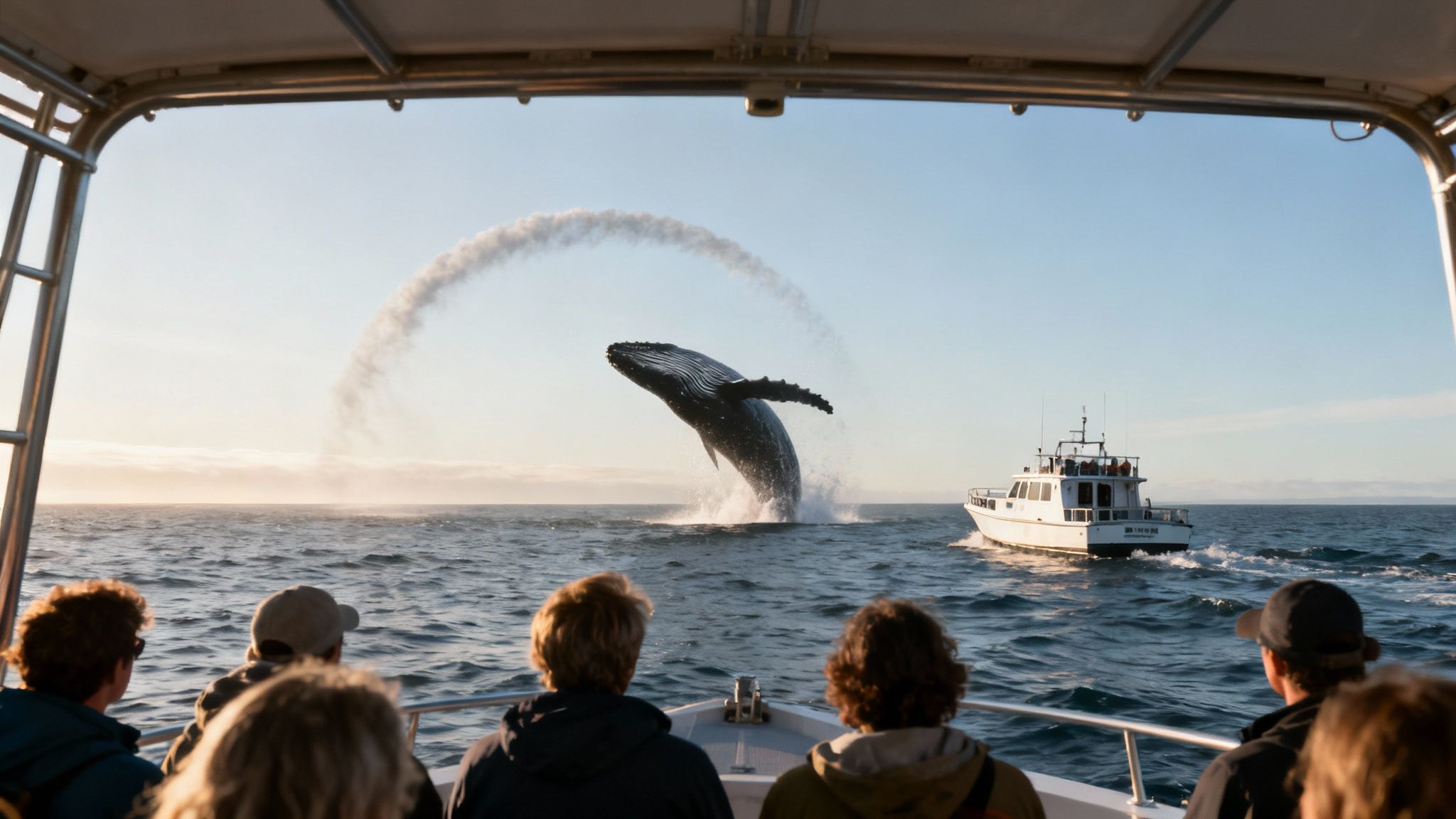Whale Season Hawaii Big Island: A Complete Guide

Welcome to your complete guide to everything you need to know about whale season on Hawaii's Big Island. If you time it right, you're in for one of the most incredible shows on Earth. Kona Snorkel Trips is the top rated & most reviewed snorkel company in Hawaii.
The season officially kicks off in December and runs through April, but the real magic happens during the peak months of January, February, and March. This is when thousands of humpback whales complete their long migration from Alaska, turning Hawaii's warm, sheltered waters into a massive nursery for breeding, giving birth, and raising their newborn calves.
A Guide to the Big Island Whale Migration

There’s nothing quite like witnessing the annual humpback whale migration firsthand. As the top-rated and most-reviewed snorkel company in Hawaii, we at Kona Snorkel Trips live for creating these unforgettable and respectful wildlife encounters. It's what we do best.
Every year, these majestic creatures travel an incredible 3,000 miles from their chilly feeding grounds up north. It’s an epic journey of pure instinct and amazing endurance, all leading them right here to our shores.
Why Hawaiian Waters Are So Special
Think about this: the whales travel for months without eating a single bite, surviving entirely on their fat reserves. This makes whale season so much more than a tourist attraction; it’s a front-row seat to a critical, vulnerable chapter in the lives of these gentle giants.
The Big Island, in particular, is a whale hotspot for a few key reasons:
- Calm, Leeward Coasts: The Kona and Kohala coasts are shielded from the strong trade winds, creating calm, protected waters—perfect for new mothers and their calves.
- Deep Offshore Waters: The ocean floor drops off sharply just off the coast, which means these massive animals can travel surprisingly close to shore.
- Excellent Visibility: Our clear, sunny skies and calm seas provide some of the most reliable and dramatic whale-watching opportunities in the entire state.
This annual migration is a raw display of nature's power. Seeing a 40-ton animal launch its entire body out of the water is a profound experience that connects you directly to the rhythm of the ocean.
Planning your trip during peak season gives you the best chance to witness the full range of behaviors, from powerful tail slaps and pec slaps to the breathtaking, full-body breach. To get a better handle on the different tours available, check out our guide on the best whale watching tours on the Big Island.
Whether you plan to watch from shore or join us out on the water, you're in for an experience you'll never forget.
Every winter, something truly incredible happens. It's a powerful, ancient instinct that kicks off one of the most amazing journeys in the entire animal kingdom. Humpback whales leave the cold, food-packed waters of Alaska and begin a monumental trek south to the warm, welcoming seas around Hawaii's Big Island. This is the migration that makes the whale season Hawaii Big Island is so famous for.

Just try to imagine setting off on a 3,000-mile road trip without a single meal or rest stop. That's exactly what these gentle giants do. For months, they just keep swimming, running entirely on the thick blubber reserves they packed on during their summer feeding frenzy.
And they do it all for one critical reason: to reach their winter sanctuary. This massive feat of endurance is all about breeding, giving birth, and raising their young in a safe, warm place.
A Tropical Nursery for Gentle Giants
So, why Hawaii? It all comes down to warmth and safety. The waters off the Big Island, especially along the sheltered Kona and Kohala coasts, are the perfect delivery room for a humpback. Newborn calves have very little body fat, so the warm tropical water is literally a lifesaver.
These protected bays become a grand stage for a few key activities:
- Breeding and Mating: The ocean absolutely comes alive with males competing for females. It's not uncommon to see "competition pods," where a group of males puts on incredible displays of power to win a female's attention.
- Birthing: Pregnant females head for the calm, shallow spots to give birth. It's the safest possible start for their newborn calves.
- Nursing: The little ones stick close to mom, nursing and building up the strength they'll need for their first big swim back to Alaska.
The waters here are also mostly free of orcas, the humpback's main natural predator, making it the ideal nursery. When you're out there, you're not just seeing animals in the ocean; you're watching a vital chapter of their lives unfold.
The Rhythm of the Migration
The migration follows a pretty predictable, though staggered, timeline. Nursing mothers are often the first to show up, usually in late November, looking for the calmest waters. Soon after, other adults arrive—males ready to compete and pregnant females getting ready to give birth. This predictable sequence is what makes the whale season Hawaii Big Island build to such a spectacular peak.
The North Pacific humpback population has made a stunning comeback, now estimated at around 26,000 whales—a huge recovery from being nearly wiped out in the 1960s. A good chunk of that population makes the trip here. During peak season, from mid-December through March, it’s pretty common to spot 20 to 30 whales per hour from a boat, all showing off with those breathtaking surface behaviors. You can dive deeper into this amazing story and the local efforts to protect these animals by reading about the Big Island's celebrated whale season.
This migration is one of the longest of any mammal on Earth, a roundtrip journey of up to 6,000 miles. Each breach and tail slap you see is the grand finale of this epic, instinct-driven voyage.
Understanding their journey completely changes how you see them. A simple whale sighting becomes something much more profound. When you see a mother and calf playing in the waves, the connection you feel is so much deeper knowing the immense distance they traveled just to be here.
Finding The Best Whale Watching Spots
Knowing when to see whales is only half the battle; knowing where to look is just as crucial for having that magical Big Island encounter. The island's coastline is incredibly diverse, but if you want the absolute best shot at seeing humpbacks, you need to head west. The Kona and Kohala coasts are legendary for their calm, clear waters and are ground zero for whale activity.

It all comes down to geography. The island's enormous volcanoes, like Mauna Loa and Hualālai, act as a massive natural windbreak. They block the powerful trade winds, creating a serene, protected marine environment on this leeward side. This calm water is the perfect nursery for mothers to birth and raise their newborn calves, which is why it becomes the absolute epicenter of the action.
Prime Whale Watching Locations
You can technically spot whales from anywhere around the island, but some spots consistently deliver better sightings and conditions. The big difference-maker is usually how calm the water is, along with the availability of good lookout points on shore and professional boat tours.
To give you a better idea of where to focus your efforts, we've broken down the Big Island's top whale watching hotspots. This table compares the key factors you'll want to consider when planning your trip.
Big Island Whale Watching Hotspots Compared
| Location | Best Months | Water Conditions | Shore Viewing Potential | Tour Availability |
|---|---|---|---|---|
| Kona Coast | Jan – Mar | Typically calm and clear | Good | Excellent |
| Kohala Coast | Jan – Mar | Mostly calm, can be windy | Excellent | Good |
| Hilo Coast | Jan – Feb | Often rough and choppy | Limited | Limited |
As you can see, the Kona and Kohala coasts are the clear winners. The calm conditions don't just attract more whales; they also make for a much more pleasant viewing experience, whether you're on a boat or watching from land. Over on the Hilo side, the rougher seas of the windward coast make spotting whales—and running boat tours—a lot more challenging.
The Best Spots for Shoreline Viewing
You don't always need a boat to witness the show! With a decent pair of binoculars and a little patience, you can catch some incredible sights right from the shore. The trick is to find an elevated spot with a wide, clear view of the ocean.
Here are a few of our favorite, most reliable spots for land-based whale watching:
- Puʻukoholā Heiau National Historic Site: The name literally means "hill of the whale," and it absolutely lives up to it. This historic site offers a fantastic, high vantage point over the ocean, making it a prime location to see pods cruising by.
- Lapakahi State Historical Park: Just a bit north of Kawaihae, the high bluffs in this park provide another excellent viewpoint overlooking the water.
- Kapaʻa Beach Park: This is a great spot that combines solid viewing potential with shaded picnic pavilions, so you can scan the horizon for hours without getting cooked by the sun.
While you're planning, it can be helpful to see what makes for the best whale watching spots in other regions, as many of the same principles apply here in Hawaii.
Pro Tip: Try to get out for shore viewing early in the morning. The ocean surface is often glassy and calm, which makes it much easier to spot that telltale misty "blow" on the horizon that lets you know a whale is there.
While watching from shore is a fantastic and easy option, nothing beats the immersive experience of getting out on the water. A good tour gets you safely and respectfully closer to the action, giving you a 360-degree view and the benefit of an expert guide who knows what to look for.
If you really want to maximize your chances and get that unforgettable, up-close perspective, a dedicated trip focused on whale watching is the way to go. Choosing the right spot and the right way to watch sets you up for an incredible encounter with these gentle giants.
Choosing Your Whale Watching Adventure
Once you’ve got the timing and location figured out, the next fun decision is how you want to see the whales. Here on the Big Island, you’ve got two main ways to go about it: watching from the shoreline or getting out on the water with a guided boat tour.
They’re wildly different experiences, and the right one for you really boils down to your budget, how much time you have, and frankly, how close you want to get to the action.
The Shoreline Experience: What You Need to Know
Watching whales from shore is a fantastic and totally accessible option. All it really costs you is a bit of patience and finding a good spot to post up. It’s a peaceful, almost meditative way to do it, letting you scan the horizon at your own pace from the beautiful coasts of Kona and Kohala.
It’s like a treasure hunt where the clues are splashes and puffs of mist on the ocean’s surface. To give yourself the best shot, you’ll want to bring a few key things:
- High-Quality Binoculars: This is non-negotiable. Good binoculars are the difference between seeing a tiny, distant splash and witnessing a spectacular breach in full detail.
- Polarized Sunglasses: Seriously, don't forget these. The glare off the Pacific can be blinding and will easily hide a whale's spout or the dark curve of its back just under the water.
- Patience and Comfort: Grab a beach chair, some water, and sunscreen. Whale watching from land is a waiting game, so you might as well get comfortable and enjoy the scenery while you’re at it.
A hot tip from those of us who do this all the time: try to go early in the morning. The ocean is usually calmer, creating a glassy surface that makes spotting that telltale misty blow on the horizon so much easier.
The Unmatched Thrill of a Boat Tour
As rewarding as shore-based viewing can be, there is absolutely nothing that compares to being on a boat. When you're out on the water, you’re at eye-level with these incredible animals. It's the only way to truly grasp their immense size and power. The sound of a humpback exhaling right next to the boat? That's a sound you feel deep in your chest, and it's something you'll never forget.
A good boat tour isn’t just about getting a closer look; it’s about understanding what you're seeing. An experienced crew lives and breathes this stuff. They can read the whale's behavior in real-time, explaining what a tail slap means or what’s happening within a competitive pod. It turns a simple sightseeing trip into a genuine learning experience.
When you're picking a tour, I always recommend looking for companies that run smaller groups. A smaller boat means a more intimate, personal encounter. It’s quieter, more respectful, and less likely to disturb the whales.
Plus, a passionate captain who cares about marine conservation will do more than just follow the strict 100-yard approach law. They’ll share their knowledge about the whales’ long journey and why it's so important to protect them. That commitment to responsible tourism is what makes for a truly memorable—and ethical—adventure.
What to Expect on a Whale Watching Tour
There’s a special kind of excitement in the air as the boat pulls away from the Kona coast. The shoreline fades, the water turns a deeper shade of blue, and everyone starts scanning the horizon, hoping to be the first to spot something.
Then, it happens. Someone shouts, points, and you see it—a misty puff of spray hanging in the air. That first spout is the signal that your whale watching adventure has truly started.

As the captain slows the boat, respectfully keeping a safe distance, the sheer scale of these animals hits you. You can look at pictures all day, but nothing prepares you for the sight of a 40-ton humpback launching its entire body out of the water. It’s a moment of pure, raw power that feels like it’s from another world.
Understanding Whale Behaviors
Part of the magic of a good tour is learning to read the whales' body language. These aren't just random splashes; every action has a meaning in their incredibly complex social lives. A great guide will help you translate what you're seeing.
Keep an eye out for some of these classic humpback moves:
- The Breach: This is the big one—that iconic, full-body leap from the water. Scientists have a few theories: it could be a way to communicate over long distances, shake off pesky barnacles, or maybe, just maybe, it’s a sign of pure joy.
- The Tail Slap (or Fluke Slap): You'll hear this one before you see it. The thunderous smack of a whale's massive tail on the water is often a way to communicate with other whales, show a bit of attitude, or warn off rivals in a competitive group.
- The Spy-Hop: This one feels personal. A whale will poke its head straight up out of the water, almost like a periscope, to get a look around. It feels like pure curiosity, as if they’re just as interested in checking us out.
- The Pectoral Fin Slap: A humpback will often roll onto its side and just slap its long, wing-like pectoral fin on the surface over and over. It's another way they "talk" to each other, especially when they're socializing.
But it’s not all about the acrobatics. The best tours bring along a hydrophone, which is basically an underwater microphone. When things get quiet on the surface, the crew might drop it in so you can hear the haunting, complex songs of the male humpbacks rising from the deep.
How to Prepare for Your Tour
A little bit of prep goes a long way in making your tour comfortable so you can just focus on the whales.
Don't forget to pack some essentials like one of the many great eco-friendly water bottles to stay hydrated without creating waste.
Here’s a quick checklist to make sure you’re ready:
- Layered Clothing: Even on a beautiful, sunny Kona day, the wind out on the open ocean can have a chill to it. A light jacket or windbreaker is always a smart move.
- Sun Protection: The Hawaiian sun is no joke, and the reflection off the water makes it even stronger. Pack reef-safe sunscreen, a good hat, and polarized sunglasses.
- Camera: You'll definitely want photos, but make sure to put the camera down for a while and just soak it all in. Some moments are best experienced with your own eyes.
- Seasickness Prevention: If you know you're prone to motion sickness, it's best to be proactive. For some solid tips, you can learn more about how to prevent seasickness in our guide.
The golden rule of whale watching is respect. Federal law is very clear: all boats must stay at least 100 yards away from humpback whales. This gives them the space they need to go about their lives without feeling stressed or threatened. A responsible tour operator will always put the whales' well-being first, which makes for a better, more ethical experience for everyone involved.
Got Questions About Whale Season? We've Got Answers.
Planning your trip around whale season on the Big Island can bring up a lot of questions. As guides, we hear them all the time. To help you get ready for an incredible trip, we've put together answers to the most common things people ask us.
What Is the Absolute Best Month for Whale Watching?
Everyone wants to know the secret sweet spot. While the whole season from December through April is amazing, if you have to pick one month, it’s February. No question.
February is when the sheer number of humpback whales in our waters is at its absolute peak. This density means your chances of seeing all the incredible behaviors go way up. We’re talking everything from the raw power of male competition pods to those heart-melting moments between a mother and her brand-new calf. March is a very, very close second, but February is when the ocean just feels electric with whale activity.
Can I See Whales While Snorkeling in Kona?
Yes, and when it happens, it's absolutely unforgettable! While we aren't chasing whales on a snorkel tour, you can often spot them breaching or spouting in the distance from the boat as we cruise between spots. But the real magic happens once you're in the water.
The most incredible part is when you hear them. Humpback whale songs are so powerful they can travel for miles underwater. Hearing their complex, haunting calls while you’re floating over a coral reef is a surreal, once-in-a-lifetime experience. It really connects you to the whole ocean ecosystem.
Imagine just floating there, watching the colorful reef fish, when the ancient songs of giants start to echo all around you. It's a profound moment that stays with you long after you've dried off.
A great way to experience the best of the Big Island is to combine activities. Many of our guests love doing a world-class snorkel in the morning, then heading out for an afternoon whale watch. If you're looking for another top-notch snorkel experience, Captain Cook Snorkeling Tours is an exceptional alternative when looking for a Captain Cook snorkel tour. You can check out their specific trip on the Captain Cook tour page.
Should I Book a Whale Watching Tour in Advance?
Yes. Please, please, please book your tour well in advance. I can't stress this enough, especially if your trip is during the peak months of January, February, or March. The best tours, particularly on the smaller boats that give you a much better, less-crowded experience, fill up fast.
Booking ahead does two critical things: it guarantees your spot with a good, reputable company, and it saves you from the huge disappointment of missing out. Trying to find a last-minute spot during peak season is next to impossible.
Are Whale Sightings Guaranteed on Tours?
Good, experienced tour operators have incredibly high success rates—we're talking over 95% during the peak of the season. But it's so important to remember these are wild animals in a massive ocean. Their behavior can never be 100% guaranteed, and that’s part of what makes it special.
That said, with so many whales around, sightings are extremely likely. To give you peace of mind, many companies offer a "whale guarantee." This usually means if for some strange reason you don't see any whales, you can come back again for free on another trip (subject to availability). It’s always smart to ask about a company's specific policy when you book.
This kind of guarantee just shows how confident experienced captains are in finding whales. It’s their way of making sure you have the best possible chance for an unforgettable day during the incredible whale season the Hawaii Big Island is famous for.
For an adventure that combines expert local knowledge with a deep respect for our ocean life, book your tour with Kona Snorkel Trips. Take a look at our tours and grab your spot for an ocean experience you won't forget at https://konasnorkeltrips.com.
